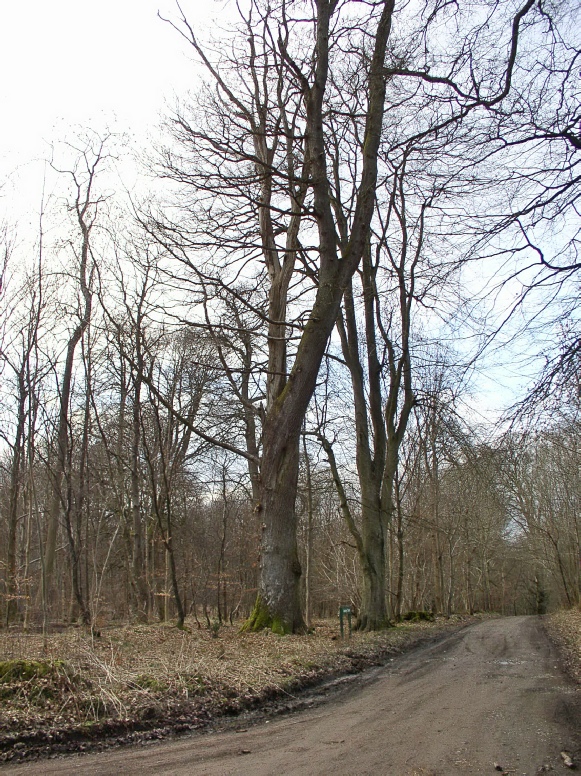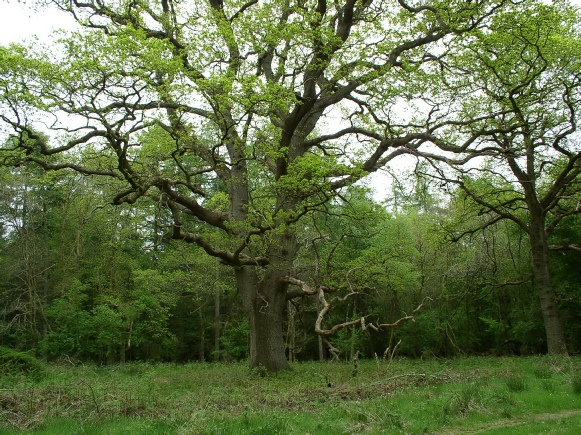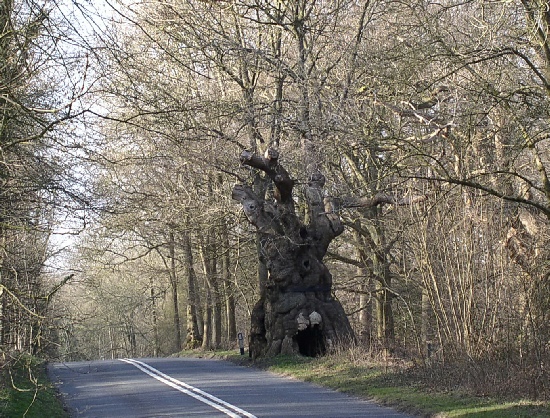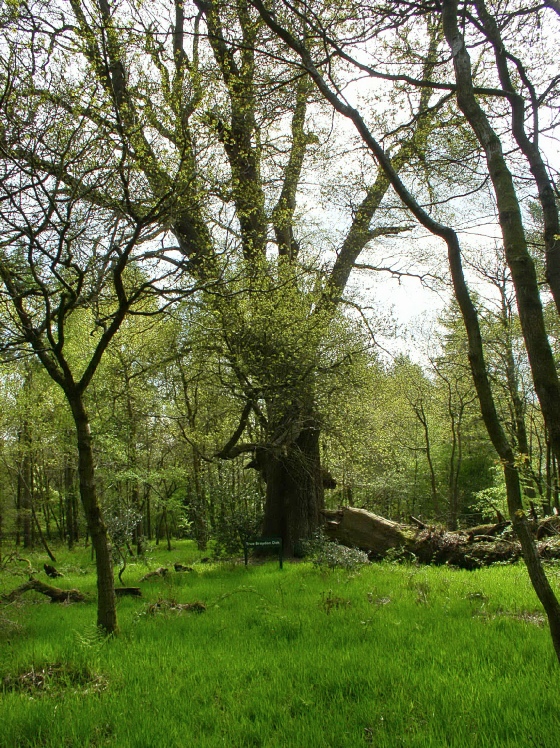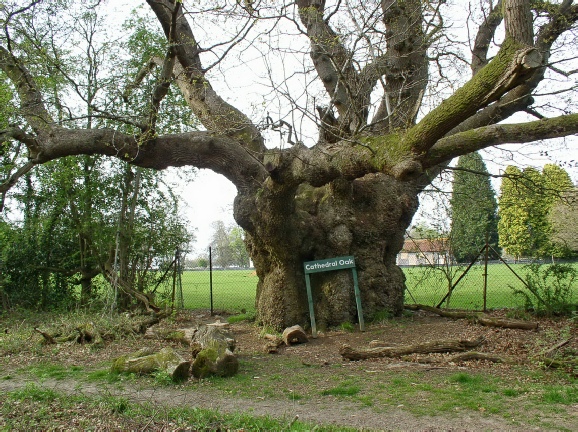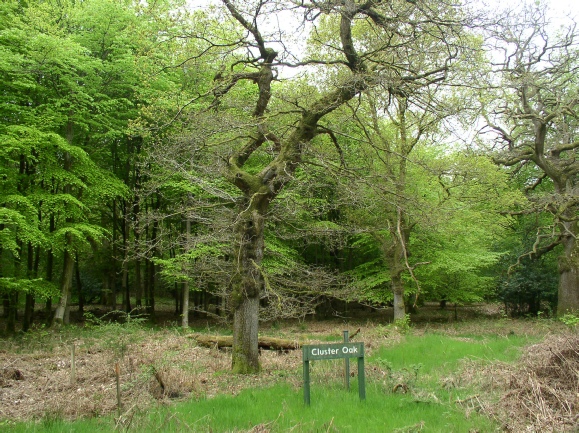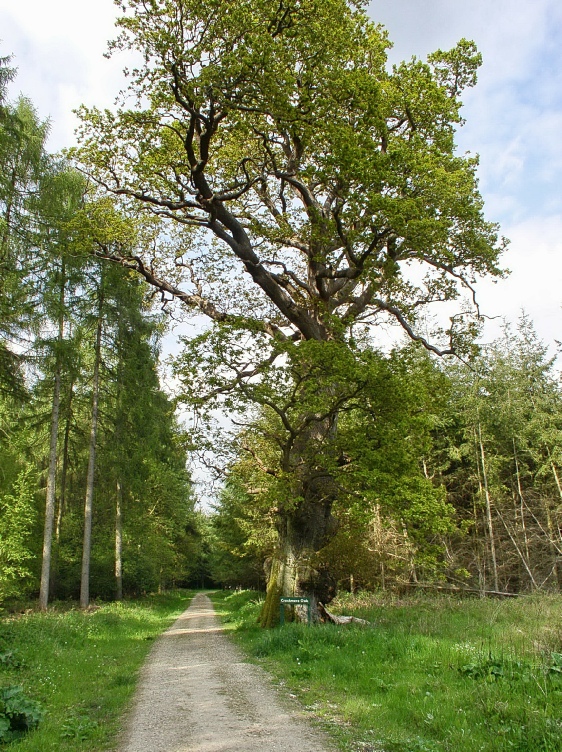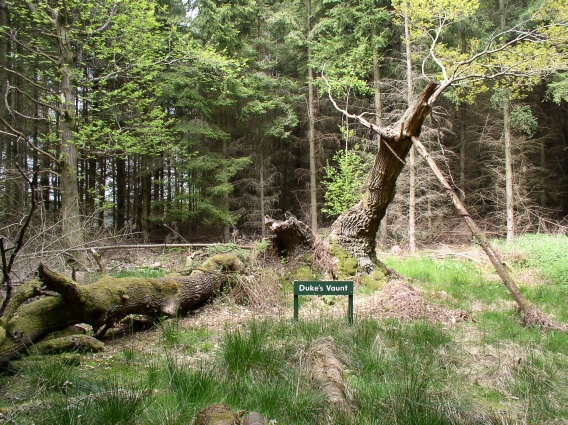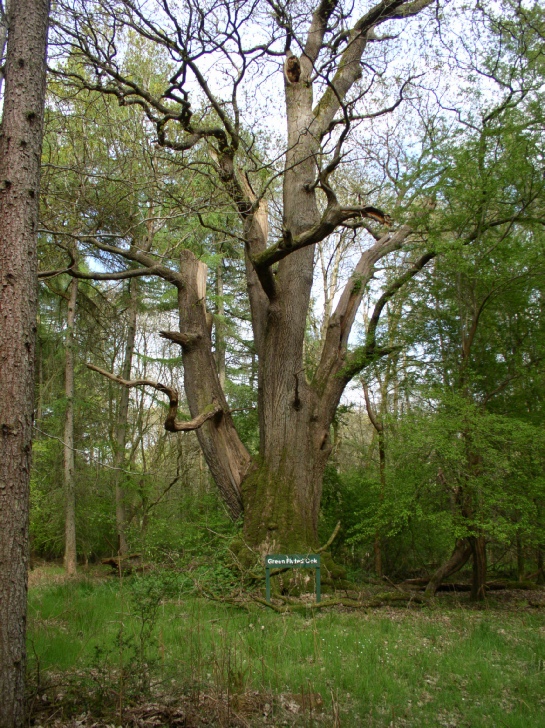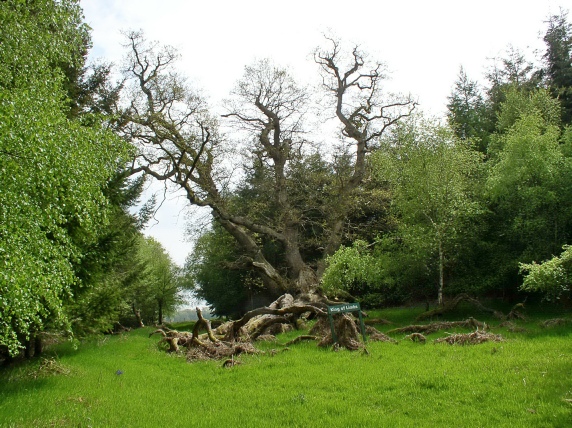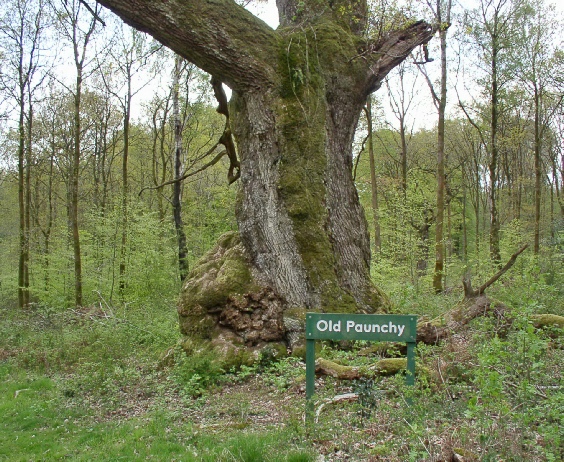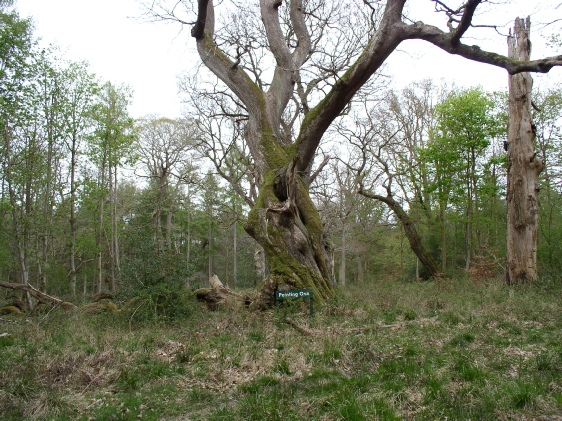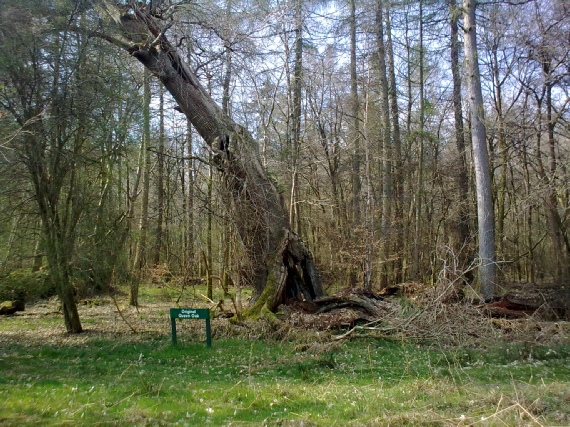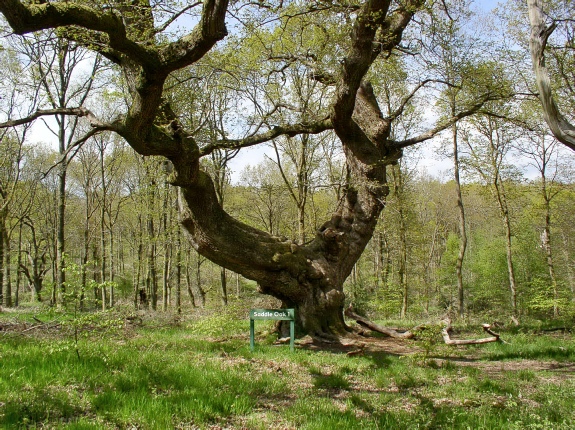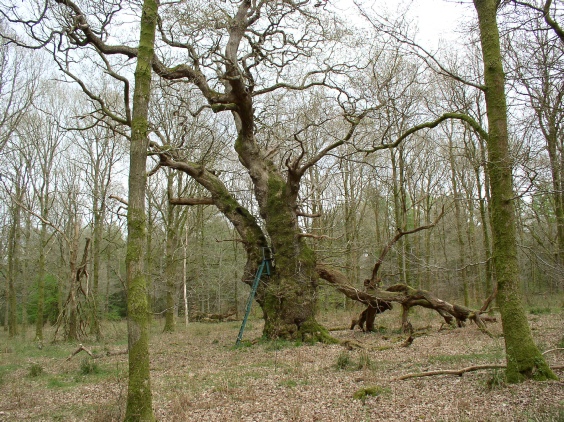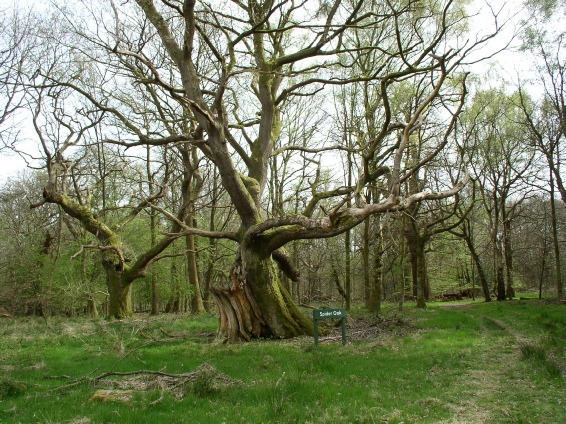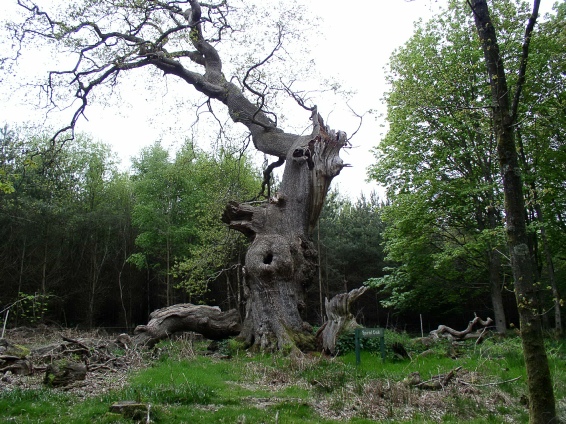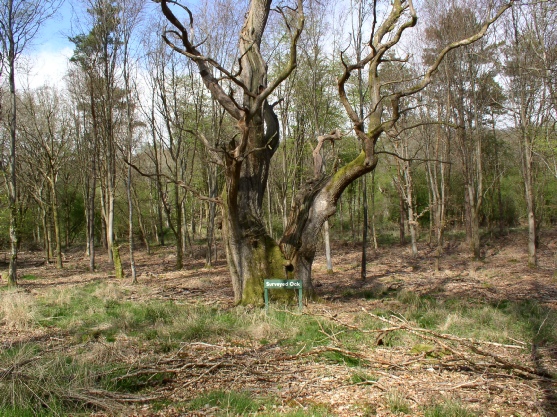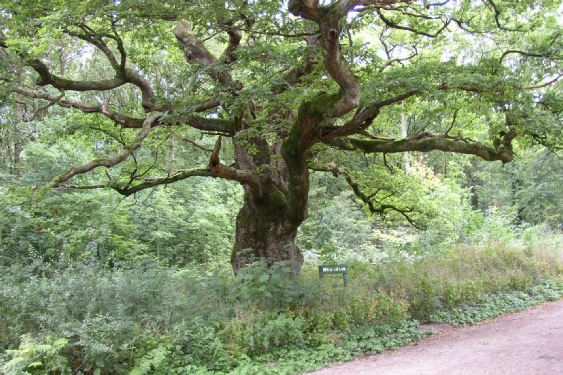






Amity Oak
In some respects The Amity Oak is one of the easiest Oaks to find, being located on the Savernake track of the same name, and it also appears on Ordnance Survey maps. The Amity Oak is a youngster, at around 200 years old, and marks the boundary between the parishes of Cadley, Great Bedwyn and Minal (Mildenhall). The derivation of the name is unknown; but it is probable that the track was named after the tree, and possibly the term ‘Amity’ is an old reference to the tree type - although Amity appears to not be a modern Oak species. Another theory is that as the tree is a boundary marker, that the tree (and track) were named from the definition of the word ‘amity’: meaning ‘peace’ or ‘friendship’. There are many old references to restricted access within Savernake, and that local villagers were not welcome within the Forest. In 1786 restrictions from Durley and St Katherine’s into Savernake were lifted, and that a route from St Katherine’s to Stitchcombe and Minal would have passed along what is now Amity Drive; this date matches the time that the Amity Oak would have been planted.
Ayers Oak
The Ayers Oak is one of two Savernake Named Oak Trees that do not currently have a Forestry Commission ‘plaque’. There are a few Web references as to the location of this tree, but ground surveys of these locations reveal nothing but modern Pine. One local publication shows the approximate position, which is correct, but locating the tree ‘on the ground’ is not easy. We are awaiting a response from the Forestry Commission about a true verification of this tree, and hopefully we will see a plaque assigned at some point in the near future.
Big Belly Oak
At between 1000 and 1100 years old, The Big Belly Oak is the UK’s oldest living oak tree. Much has been written about this tree, with its metal ‘belt’, with its position well recorded on all maps. Access to this tree from within the Forest is a little tricky; in summertime the dense brambles makes boots and gaiters necessary.
True Braydon Oak
Much has been written about the Braydon Oak (‘Braden’ or Broad Oak), with some saying that it was/is in the grounds of Braydon Hook House. At the turn of the last century there was most certainly what appears to be an old Oak close to the southern aspect of the house, but this was felled at some point between 1906 and 1956. However, that tree exhibited a ‘stoop’, whilst photographic evidence of the real Braydon Oak in 1906 reveals a more typical 400 year-old upright Oak tree. Braydon Hook House is surrounded by Veteran Oak Trees of around 300 - 400 years old, but older maps of the area show that what is now known as the ‘True Braydon Oak’ lies beyond the grounds of the house, but still within the Braydon Hook area.
Cathedral Oak
The Cathedral or Millennium Oak is a spectacular tree with a girth nearly 10m, showing that this tree is at least 1000 years old; it is probably the seconds oldest tree in Savernake, and maybe the second oldest in the UK. The tree is in excellent condition for its age, and makes photographic subject in early Spring. The Cathedral Oak is situated close to one of the Savernake Picnic areas, yet most visitors are not aware of its presence!
Cluster Oak (The Savernake Cluster Oak)
Most Savernake ‘Cluster Oak’ texts refer to the plural: ‘Cluster Oaks’, i.e., groups of similarly aged Oak trees planted together, or having grown together. However, a ‘Cluster Oak’ is actually a slow-growing species of oak: “Quertus pedunculuta Erhart var. cristata A.Henry vel. Q robur L. var. Cristata” (Henry 1917). The essential description of the main features are: “Leaves densely clustered, small, contorted, oblique, the midrib dividing the blade into two unequal halves” (Bean 1992). The Savernake Cluster Oak was planted in 1796, and is an important Notable tree, also known as ‘The Savernake Cluster Oak’. It has several progeny - one being The Replacement King Oak. If it were not for the Forestry Commission green ‘plaque’ you would easily dismiss this tree, its slow growth gives it a girth of less than 2m and height of 15m, with nearby younger Beech and Oak trees towering above it.
Creeping Oak
So named because of a ‘stooping’ or ‘kneeling’ branch - this tree was described by Strutt in 1826 in his “Sylva Britannica” as follows: “the circumstance of one of its main limbs having crept so closely to the earth in its youth, that in its old age it actually reclines the weight of its increasing years upon the ground ; forming, in doing so, a pleasing irregularity of out- line very agreeable to the eye of a painter.....” The tree was reported as being very close to one of the other famous named trees, and no evidence has been found to show that it still survives. A great pity.
Crockmere Oak
Little is known about this tree, nor the nearby pond. From its size, it will be around 450 - 500 years old; it is in fair condition, although the base is showing some rotting and hollowing.
Duke’s Vaunt Oak
The Duke’s Vaunt (or ‘Vault’) is about 1000 years old. It was reportedly the pride and joy of Edward Seymour, Jane Seymour’s brother and the 1st Duke of Somerset. In 1762 it was reported to have a door and lock fitted to its mammoth hollow trunk, and that “it was capable of sheltering twenty choir boys"! The tree is in very poor condition, having split longitudinally, but it is still living, but only just..... Locating the tree is difficult, many Web references show an incorrect OS coordinate. Join a Wiltshire Walks visit to this tree whilst it is still alive!
Green Fluted Oak
A little-known tree, in good condition, and about 500 years old. An impossible tree to find, only our Web Site has any reference to this tree, which would only be found by sheer accident, or through bribery of one of our Path Leaders!
King of Limbs
Another 1000+ year-old tree, lying on the outskirts of the Estate, in a fabulous environment; its position would make it a Parish boundary tree. One of the most magnificent trees in the Forest, this tree has to be seen! ‘Radiohead’ fans wander The Forest attempting to locate this tree...... ! Book our S10/11/12 Walks to visit this tree, or email us for information on a Tailored Walk to see this tree.
The Original King Oak
The location of this tree is well-documented, with many locals saying that they have visited this tree in the past. They would have to be well over 75 for this to be true - The Original King Oak was cut into small pieces and given to departing American servicemen at the end of the last War!!
Replacement King Oak
The Replacement King Oak stands close to the position of the Original King, and was planted in the 1980s. Although obviously not an Ancient or Veteran tree, the Replacement could be given ‘Notable’ status, and it is one of a handful of progenies of The Savernake Cluster Oak.
Old Paunchy
One of the modern named trees in Savernake, this tree is probably some 700 years old. Easily found, if you know where to look, but missed by many.........
Pointing Oak
Sadly, the Pointing Oak now longer points; the ‘pointing finger’ branch has decayed and fallen, with a second major limb fallen during this June. Perhaps the Forestry Commission could name one of the many other elderly trees that have a similar attribute? Very easy to find.
New Queen Oak
The ‘New Queen Oak’ lies south-west of the Original Queen Oak and is a future replacement for that tree. However, the New Queen appears to be in a worse condition than the Original!
Original Queen Oak
An easy tree to find as this is marked on Ordnance Survey maps.
Saddle Oak 1 and Saddle Oak 2
These two trees stand together (although we are amazed at how many people ask “I found Saddle Oak 1 today, can you tell me where Saddle Oak 2 is?) and are great examples of Saddle Oaks, formed from the pollarding process applied to these trees when they were young. There are hundreds of such trees in Savernake; many are equal to the two named Saddle Oaks - their contorted limbs would have been used in the woodworking of timber for ships and furniture.
Slingsby Oak
This is the second Named Tree in Savernake that has no Forestry Commission green ‘plaque’. It lies in an area containing many other Ancient Oak trees, but this tree has the ‘edge’ on those others. Again, we are awaiting verification of this tree.
Spider Oak
Another magnificent tree, which has unfortunately succumbed to the weather and lost some of its many limbs. Easy to find when searching for other named trees.
Spiral Oak
Yet another large tree that has lost some of its spiraling limbs. Fairly well-hidden and off the beaten track.
Surveyed Oak
An interesting Ancient Tree which is missed by many. This tree has been recorded by the Ordnance Survey in the past, simple named “Oak”. It would appear that the Forestry Commission renamed this tree after a ground search for it. It’s an old tree, in good condition for its age, is an old boundary marker.
Turkey Oak
No, we haven’t seen a turkey in Savernake, yet! This species was introduced from Turkey in the 2nd half of the 19th century and was earlier called the Wainscot oak as it makes ideal wall panelling. Turkey oaks exhibit the reverse characteristic of a Cluster Oak - it has a very fast rate of growth. There are around a half-dozen such Oaks in Savernake; most being on private land. This particular Oak is easy to find, and is a relatively young Notable tree of fair proportions.
White Road Oak
Another magnificent tree, possibly a boundary marker, and close to ‘civilisation’ - yet so many walkers miss this tree........
with one more tree (not an oak) being shown on Ordnance Survey Maps:
Beech
We have gone back to maps dated to 1916 and beyond, and used our magical “Map Maker Pro” software to pinpoint the position of this tree. Being a Beech it has no FC green ‘plaque’, but it does bear a modern Commission aluminium Tag.
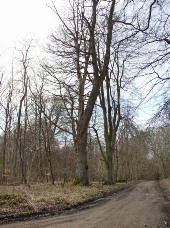
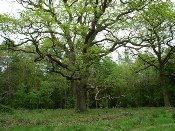
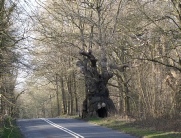
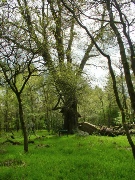
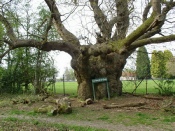
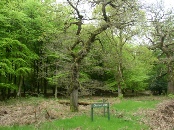
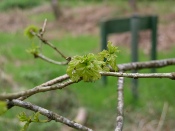
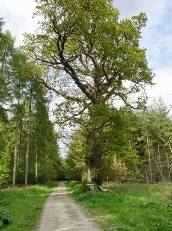
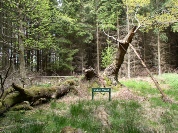
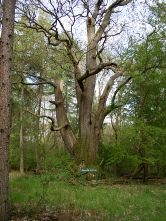
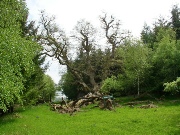
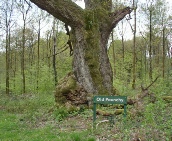
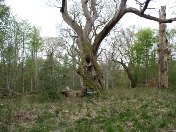
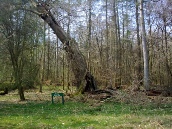
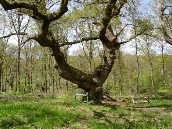
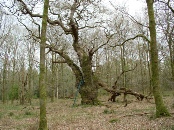
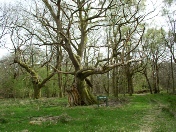
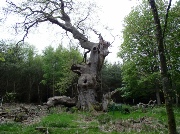
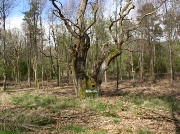
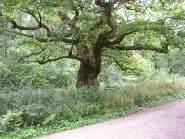
‘Hover’ over any Picture for a larger image

| Avebury |
| Kennet Valley |
| Martinsell |
| Marlborough |
| Savernake |
| Villages |
| West Woods |
| Custom Walks |
| Self-Guided Walks |
| Map & Compass |
| Ley Line Dowsing |
| Ancient Trees |
| Walking for Beginners |
| Beginners Backpacking |
| Geocaching |
| Corporate |
| Activities |
| Activities |
| Corporate |
